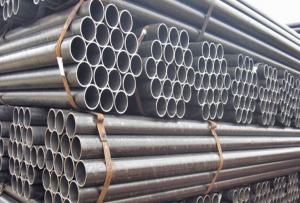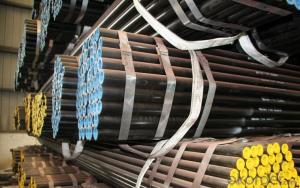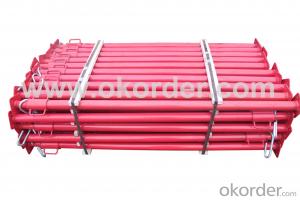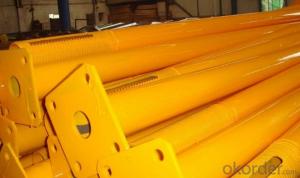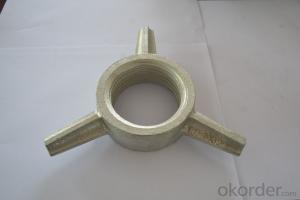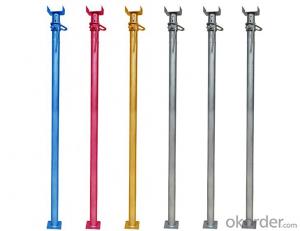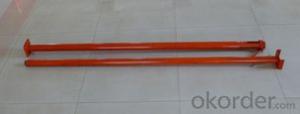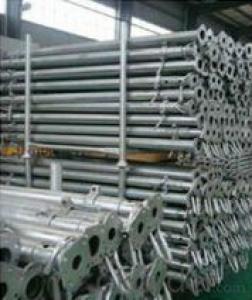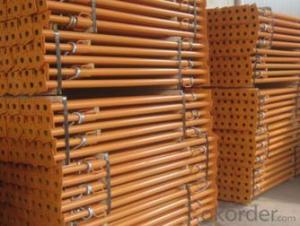Scaffolding pipe support system steel prop
- Loading Port:
- China Main Port
- Payment Terms:
- TT OR LC
- Min Order Qty:
- -
- Supply Capability:
- -
OKorder Service Pledge
Quality Product, Order Online Tracking, Timely Delivery
OKorder Financial Service
Credit Rating, Credit Services, Credit Purchasing
You Might Also Like
Quick Details
| Place of Origin: | Name: | ||||
| Adjustable Size: | Thickness: | Finishment: | |||
| MOQ: | Delivery Time: | Payment Term: | |||
| Business Type: | Color: | Location: |
Packaging & Delivery
| Packaging Detail: | In bundle or in bulk or as your request,normally in bulk can be loaded 1800-2500pcs for different size in one 20ft container. |
| Delivery Detail: | 10 to 30 days after order confirmation |
Specifications
construction props
1)Manufacturer 10 years ;
2)OEM offered,
3)Formwork,beam,concrete,slab support,
4)Promptly delivery.
| Name | construction props |
| Place of Origin | Guangzhou China |
| Size | Ø40- Ø48/Ø48- Ø56 or as your request |
| Main Material | Q235, Q195 |
| Surface Treatment | High Protected Painted, Powder Coating, Electric Gavenized, Hot Dip Gavenized. |
| Color | Silver, red,orange |
| Certificate | SGS, |
| Service | OEM Service available |
| MOQ | 500pcs |
| Payment | T/T |
| Delivery Time | 10-30 days after confirmation |
| Packing | In bulk or steel pallet or as your request |
| Production capability | 200 tons per day |
- Q:Can steel props be used in water treatment plant construction?
- Steel props, also referred to as adjustable steel props or steel shore props, can indeed be utilized in the construction of water treatment plants. These props are commonly employed in construction projects to temporarily support and stabilize structures. They possess the ability to provide vertical support and can be adjusted to accommodate various construction needs. In the context of water treatment plant construction, steel props fulfill a multitude of purposes. For instance, they can provide support to formwork during the construction of concrete structures like tanks, basins, and walls. Furthermore, steel props are ideal for temporarily supporting heavy machinery and equipment during installation or maintenance tasks. The utilization of steel props in water treatment plant construction is favored due to their inherent strength and durability. Crafted from high-quality steel, they are capable of withstanding the challenging conditions typically found in water treatment plants, including exposure to moisture, chemicals, and high humidity. Additionally, these props can be easily adjusted and securely fastened, ensuring precise positioning and alignment of structures, pipes, or equipment. Nevertheless, it is crucial to consider the specific requirements and regulations of the water treatment plant project when implementing steel props. Factors such as load capacity, corrosion resistance, and adherence to safety standards must be thoroughly assessed to guarantee the appropriate and safe utilization of steel props in water treatment plant construction.
- Q:How does a steel prop work?
- A steel prop, also known as a steel shore or acrow prop, is a temporary vertical support structure used in construction and renovation projects. It is primarily used to provide temporary support to beams, walls, ceilings, and other structural components during construction or repair work. The working principle of a steel prop is quite straightforward. It consists of two main components: an adjustable steel tube and a steel plate. The steel tube is telescopic, with an inner tube sliding into an outer tube, allowing for height adjustment. The steel plate, also known as a base plate or footplate, provides stability and distributes the load onto the ground or supporting surface. To use a steel prop, the adjustable tube is extended to the desired height and secured in place by tightening a locking mechanism. The steel plate is then placed under the load-bearing element that requires support. The weight of the structure above is transferred through the steel plate to the ground or supporting surface. The strength and stability of a steel prop come from its robust construction and the ability to adjust its height. The telescopic design allows for easy customization to match the required height, making it suitable for various construction scenarios. Additionally, the adjustable nature of the prop enables it to compensate for uneven surfaces or changes in height during the construction process. Steel props are commonly used in applications such as supporting walls during demolition, providing temporary support to beams or ceilings during renovation, or stabilizing structures during construction. They play a crucial role in maintaining the integrity and safety of the surrounding structures by preventing unwanted movement or collapse. In summary, a steel prop works by providing temporary vertical support to structures during construction or repair work. Its telescopic design and adjustable height allow for customization and adaptability to different construction scenarios. The steel prop's robust construction and load-bearing capacity ensure stability and safety during the construction process.
- Q:Can steel props be used for supporting temporary signage or billboards in windy areas?
- Yes, steel props can be used for supporting temporary signage or billboards in windy areas. Steel props are known for their strength and stability, which makes them ideal for withstanding strong winds. They provide a secure and reliable support system that can withstand the forces exerted by wind on the signage or billboard. Additionally, steel props can be easily adjusted or reinforced as needed to ensure the stability and safety of the temporary signage or billboard in windy conditions.
- Q:Can steel props be used in dam construction?
- Yes, steel props can be used in dam construction. Steel props provide strong support and stability during the construction process, ensuring the safety and structural integrity of the dam.
- Q:How do you ensure proper anchoring of steel props in sandy soil?
- To achieve proper anchoring of steel props in sandy soil, several steps can be taken: 1. Begin by determining the load requirements. Understanding the weight that the steel props need to support is crucial in determining the appropriate anchoring method. 2. Select a suitable prop design. Different prop designs offer various anchoring options. It is essential to choose a design that is specifically suitable for sandy soil conditions. Look for features such as large base plates or flanges, which enhance stability and prevent sinking. 3. Dig deep holes. Creating stable foundations for the steel props requires digging deep holes in the sandy soil. The depth of the holes will depend on the load requirements and specific soil conditions. Seeking guidance from a structural engineer or geotechnical expert regarding hole depth is advisable. 4. Compact the soil. After the holes have been dug, it is important to compact the soil at the base to increase stability. This can be accomplished by using a compactor or by firmly tamping the soil after adding water. 5. Consider using concrete footings. To reinforce the stability of the steel props, concrete footings can be utilized at the bottom of the holes. By pouring concrete into the holes and allowing it to set, additional support is provided, preventing sinking or shifting. 6. Install adequate bracing. Depending on the height and load requirements of the steel props, it may be necessary to install proper bracing to ensure stability. This can be achieved by using diagonal supports or cross bracing between props. 7. Regularly inspect and maintain. To ensure the ongoing security and stability of the steel props and their anchoring system, regular inspections are essential. Look for any signs of sinking, shifting, or other issues that could compromise their integrity. Address any problems immediately to prevent accidents or structural failure. It is important to note that the specific requirements for anchoring steel props in sandy soil can vary depending on factors such as the project's scope, soil conditions, and local building codes. Therefore, it is always recommended to consult with professionals, such as structural engineers or geotechnical experts, to ensure proper anchoring techniques are employed.
- Q:How do steel props contribute to the prevention of floor and wall deflection?
- Steel props contribute to the prevention of floor and wall deflection by providing temporary support and stability during construction or renovation projects. These props are adjustable and can be installed vertically to bear the weight of the floors and walls, ensuring they remain in their intended position. By providing additional support, steel props help distribute the load evenly, minimizing deflection or sagging that could occur due to excessive weight or movement.
- Q:Can steel props be used in the installation of temporary seating or bleachers?
- Yes, steel props can be used in the installation of temporary seating or bleachers. Steel props provide strong structural support and stability, making them suitable for temporary seating or bleacher installations. They can be easily adjusted to the required height and provide a secure foundation for the seating or bleacher structure.
- Q:Can steel props be used for supporting temporary swimming pool structures?
- Yes, steel props can be used for supporting temporary swimming pool structures. Steel props are commonly used in construction to provide temporary support to structures, including swimming pools. They offer stability, strength, and adjustability, making them suitable for holding up temporary structures such as swimming pools during construction or events.
- Q:How do you prevent steel props from sinking in sandy soil?
- There are several techniques available to prevent steel props from sinking in sandy soil. These methods include: 1. Enhancing the surface area: Improving weight distribution and reducing sinking can be achieved by using a larger base plate or spreading the load over a wider area. Attaching a larger plate or using a timber soleplate under the steel prop can help achieve this. 2. Utilizing load-bearing plates: Load-bearing plates, also known as soleplates, can distribute the weight over a larger area. These plates, typically made of steel or timber, can be attached to the bottom of the steel prop, spreading the load and preventing sinking. 3. Adding reinforcements: Enhancing the stability of the soil around the steel prop can be done by installing steel or timber stakes or using geotextiles or geogrids to strengthen the soil. These reinforcements prevent the soil from giving way under the weight of the prop. 4. Installing ground anchors: Ground anchors provide additional support and prevent sinking. Made of steel, these anchors are driven deep into the ground. Attaching the steel prop to these anchors transfers the load to more stable soil layers, minimizing sinking risks. 5. Moistening the soil: Increasing the cohesion and density of sandy soil can make it more resistant to sinking. Regularly watering the area around the steel props can compact the soil, reducing the chances of sinking. 6. Seeking professional guidance: When facing challenging sandy soil conditions, it is advisable to consult with a structural engineer or geotechnical expert. They can assess the site, recommend suitable solutions, and provide effective guidance for preventing steel props from sinking. It is important to recognize that the choice of technique will depend on specific soil conditions, load requirements, and project duration. Therefore, evaluating the site and consulting with experts is crucial to determine the most appropriate measures for preventing steel props from sinking in sandy soil.
- Q:Are steel props resistant to extreme weather conditions?
- Yes, steel props are generally resistant to extreme weather conditions. Steel is a durable material that can withstand harsh weather elements such as high winds, heavy rain, and extreme temperatures. However, it is important to ensure proper maintenance and inspection of steel props to ensure their continued resistance to weather conditions.
1. Manufacturer Overview |
|
|---|---|
| Location | |
| Year Established | |
| Annual Output Value | |
| Main Markets | |
| Company Certifications | |
2. Manufacturer Certificates |
|
|---|---|
| a) Certification Name | |
| Range | |
| Reference | |
| Validity Period | |
3. Manufacturer Capability |
|
|---|---|
| a)Trade Capacity | |
| Nearest Port | |
| Export Percentage | |
| No.of Employees in Trade Department | |
| Language Spoken: | |
| b)Factory Information | |
| Factory Size: | |
| No. of Production Lines | |
| Contract Manufacturing | |
| Product Price Range | |
Send your message to us
Scaffolding pipe support system steel prop
- Loading Port:
- China Main Port
- Payment Terms:
- TT OR LC
- Min Order Qty:
- -
- Supply Capability:
- -
OKorder Service Pledge
Quality Product, Order Online Tracking, Timely Delivery
OKorder Financial Service
Credit Rating, Credit Services, Credit Purchasing
Similar products
New products
Hot products
Related keywords
